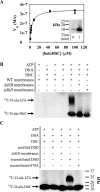A partial reconstitution implicates DltD in catalyzing lipoteichoic acid d-alanylation
- PMID: 30237166
- PMCID: PMC6240853
- DOI: 10.1074/jbc.RA118.004561
A partial reconstitution implicates DltD in catalyzing lipoteichoic acid d-alanylation
Abstract
Modifications to the Gram-positive bacterial cell wall play important roles in antibiotic resistance and pathogenesis, but the pathway for the d-alanylation of teichoic acids (DLT pathway), a ubiquitous modification, is poorly understood. The d-alanylation machinery includes two membrane proteins of unclear function, DltB and DltD, which are somehow involved in transfer of d-alanine from a carrier protein inside the cell to teichoic acids on the cell surface. Here, we probed the role of DltD in the human pathogen Staphylococcus aureus using both cell-based and biochemical assays. We first exploited a known synthetic lethal interaction to establish the essentiality of each gene in the DLT pathway for d-alanylation of lipoteichoic acid (LTA) and confirmed this by directly detecting radiolabeled d-Ala-LTA both in cells and in vesicles prepared from mutant strains of S. aureus We developed a partial reconstitution of the pathway by using cell-derived vesicles containing DltB, but no other components of the d-alanylation pathway, and showed that d-alanylation of previously formed lipoteichoic acid in the DltB vesicles requires the presence of purified and reconstituted DltA, DltC, and DltD, but not of the LTA synthase LtaS. Finally, based on the activity of DltD mutants in cells and in our reconstituted system, we determined that Ser-70 and His-361 are essential for d-alanylation activity, and we propose that DltD uses a catalytic dyad to transfer d-alanine to LTA. In summary, we have developed a suite of assays for investigating the bacterial DLT pathway and uncovered a role for DltD in LTA d-alanylation.
Keywords: DLT pathway; DltB; MBOAT; Staphylococcus aureus (S. aureus); acyltransferase; cell wall; membrane protein; pathway reconstitution; teichoic acid.
© 2018 Wood et al.
Conflict of interest statement
The authors declare that they have no conflicts of interest with the contents of this article
Figures






Similar articles
-
Biosynthesis of lipoteichoic acid in Lactobacillus rhamnosus: role of DltD in D-alanylation.J Bacteriol. 2000 May;182(10):2855-64. doi: 10.1128/JB.182.10.2855-2864.2000. J Bacteriol. 2000. PMID: 10781555 Free PMC article.
-
D-alanylation of lipoteichoic acid: role of the D-alanyl carrier protein in acylation.J Bacteriol. 2001 Mar;183(6):2051-8. doi: 10.1128/JB.183.6.2051-2058.2001. J Bacteriol. 2001. PMID: 11222605 Free PMC article.
-
Incorporation of D-alanine into lipoteichoic acid and wall teichoic acid in Bacillus subtilis. Identification of genes and regulation.J Biol Chem. 1995 Jun 30;270(26):15598-606. doi: 10.1074/jbc.270.26.15598. J Biol Chem. 1995. PMID: 7797557
-
The dlt operon in the biosynthesis of D-alanyl-lipoteichoic acid in Lactobacillus casei.Microb Drug Resist. 1996 Spring;2(1):77-84. doi: 10.1089/mdr.1996.2.77. Microb Drug Resist. 1996. PMID: 9158726 Review.
-
Lipoteichoic acid synthesis and function in gram-positive bacteria.Annu Rev Microbiol. 2014;68:81-100. doi: 10.1146/annurev-micro-091213-112949. Epub 2014 May 5. Annu Rev Microbiol. 2014. PMID: 24819367 Review.
Cited by
-
Identification of Pneumococcal Factors Affecting Pneumococcal Shedding Shows that the dlt Locus Promotes Inflammation and Transmission.mBio. 2019 Jun 18;10(3):e01032-19. doi: 10.1128/mBio.01032-19. mBio. 2019. PMID: 31213554 Free PMC article.
-
Systematic Assessment of Accessibility to the Surface of Staphylococcus aureus.ACS Chem Biol. 2021 Nov 19;16(11):2527-2536. doi: 10.1021/acschembio.1c00604. Epub 2021 Oct 5. ACS Chem Biol. 2021. PMID: 34609132 Free PMC article.
-
Mechanism of D-alanine transfer to teichoic acids shows how bacteria acylate cell envelope polymers.Nat Microbiol. 2023 Jul;8(7):1318-1329. doi: 10.1038/s41564-023-01411-0. Epub 2023 Jun 12. Nat Microbiol. 2023. PMID: 37308592 Free PMC article.
-
Bactofencin A Displays a Delayed Killing Effect on a Clinical Strain of Staphylococcus aureus Which Is Greatly Accelerated in the Presence of Nisin.Antibiotics (Basel). 2025 Feb 11;14(2):184. doi: 10.3390/antibiotics14020184. Antibiotics (Basel). 2025. PMID: 40001428 Free PMC article.
-
DltC acts as an interaction hub for AcpS, DltA and DltB in the teichoic acid D-alanylation pathway of Lactiplantibacillus plantarum.Sci Rep. 2022 Jul 30;12(1):13133. doi: 10.1038/s41598-022-17434-2. Sci Rep. 2022. PMID: 35907949 Free PMC article.
References
-
- Kovács M., Halfmann A., Fedtke I., Heintz M., Peschel A., Vollmer W., Hakenbeck R., and Brückner R. (2006) A functional dlt operon, encoding proteins required for incorporation of d-alanine in teichoic acids in Gram-positive bacteria, confers resistance to cationic antimicrobial peptides in Streptococcus pneumoniae. J. Bacteriol. 188, 5797–5805 10.1128/JB.00336-06 - DOI - PMC - PubMed
Publication types
MeSH terms
Substances
Associated data
- Actions
Grants and funding
LinkOut - more resources
Full Text Sources
Other Literature Sources
Molecular Biology Databases

